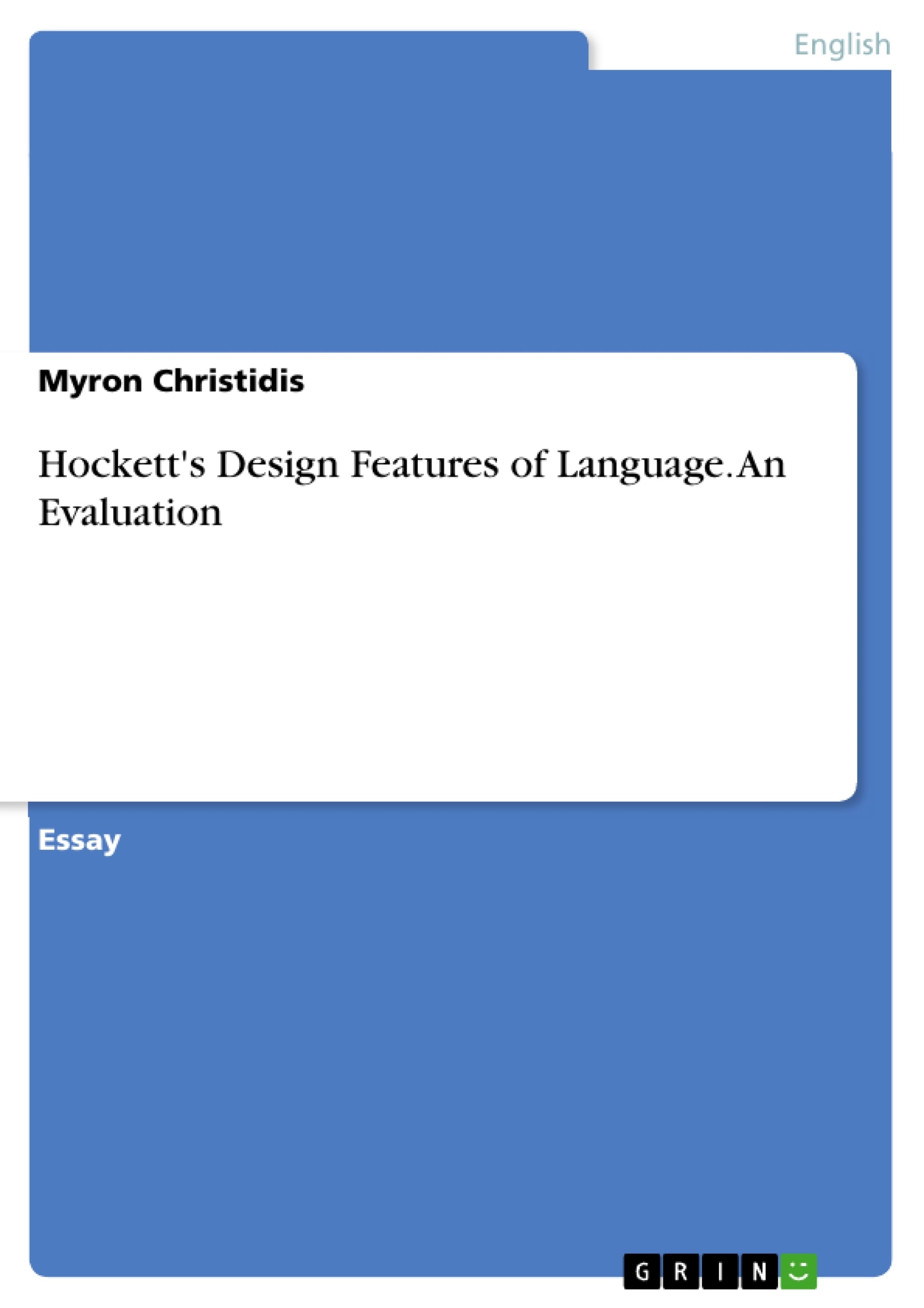This essay will attempt to elaborate which of Charles F. Hockett’s original design features truly qualify as defining and distinctive characteristics of human language in contrast to animal communication systems.
As the self-proclaimed superior species, humanity has always been very fascinated with discovering how special and unique we really are. One genuinely amazing aspect about human beings that supposedly sets us apart from other creatures is our ability to invent, produce and evolve language. Of course, animals have their own ways of communication and thus remains the question of where the actual differences lie. In an attempt to gather defining and more or less exclusive characteristics of human language, linguist Charles F. Hockett proposes thirteen criteria, which he calls the "design-features" of language.
According to Hockett there is evidence that every human language of the world shares these features. The goal of this effort, as Hockett himself states several years after the publication of the original article, was to discover "in just what ways human language differs from the communicative systems of other animals" and thus to define human language in contrast to animal communication.
Table of Contents
- Hockett’s Design Features
- Criticisms of Hockett’s Features
- Relevance and Complexity of Hockett’s Features
- Arbitrariness
- Iconicity
- Hockett’s Design Features: Work in Progress
- Hockett’s Design Features: Relevance for Human Language
- Limitlessness of Human Language
- Displacement
- Arbitrariness, Displacement and the Unlimitedness of Human Language
- Productivity
- Productivity: An Unlimited Range of Utterances
- Prairie Dog Communication
Objectives and Key Themes
This essay examines Charles F. Hockett’s thirteen design features of language, originally proposed in 1960, to determine which characteristics truly define human language in contrast to animal communication systems.
- The essay critically evaluates the relevance and complexity of Hockett’s design features.
- It explores the concepts of arbitrariness, iconicity, and productivity as defining characteristics of human language.
- The essay analyzes the limitations of animal communication systems compared to the unlimited potential of human language.
- It discusses the implications of Hockett’s design features for understanding the evolution and nature of human language.
- The essay considers the potential for animal communication, particularly in prairie dogs, to challenge Hockett’s framework.
Chapter Summaries
- Hockett’s Design Features: This section introduces Hockett’s thirteen design features of language and explains their significance in understanding the uniqueness of human communication.
- Criticisms of Hockett’s Features: This section explores critiques of Hockett’s design features, highlighting the lack of a hierarchical structure and the limitations of simply listing characteristics to define a complex system.
- Relevance and Complexity of Hockett’s Features: This section examines the varying degrees of complexity and relevance found within Hockett’s design features, particularly focusing on the vocal-auditory channel and arbitrariness.
- Arbitrariness: This section explores the concept of arbitrariness, arguing that it is not a perfect definition of human language due to the presence of iconicity in signed languages and onomatopoeia in spoken languages.
- Iconicity: This section examines the presence of iconicity in signed languages and animal communication, challenging the notion of arbitrariness as a defining feature of human language.
- Hockett’s Design Features: Work in Progress: This section acknowledges that Hockett’s design features are a work in progress and that he himself recognized their limitations and potential for further development.
- Hockett’s Design Features: Relevance for Human Language: This section emphasizes that while not all design features apply to every language, a group of features can be identified as revolving around the limitlessness of human language.
- Limitlessness of Human Language: This section focuses on the concept of limitlessness in human language, arguing that it is the ability to evolve and adapt that distinguishes human language from animal communication systems.
- Displacement: This section introduces the design feature of displacement, which refers to the ability to communicate about things that are not physically present.
- Arbitrariness, Displacement and the Unlimitedness of Human Language: This section further examines the relationship between arbitrariness, displacement, and the unlimited potential of human language.
- Productivity: This section introduces the design feature of productivity, which suggests that humans can produce and understand an unlimited number of utterances.
- Productivity: An Unlimited Range of Utterances: This section explores the concept of productivity and how it enables humans to create new expressions and invent new words.
- Prairie Dog Communication: This section examines the communication system of prairie dogs, which challenges the idea of human language as uniquely capable of productivity.
Keywords
This essay explores the design features of language, focusing on arbitrariness, displacement, and productivity. It examines the unique characteristics of human language compared to animal communication systems, drawing on examples from sign languages, vervet monkeys, bees, and prairie dogs. The essay ultimately seeks to understand the unlimited potential of human language and its ability to evolve and adapt.
- Quote paper
- Myron Christidis (Author), 2022, Hockett's Design Features of Language. An Evaluation, Munich, GRIN Verlag, https://www.grin.com/document/1312737



